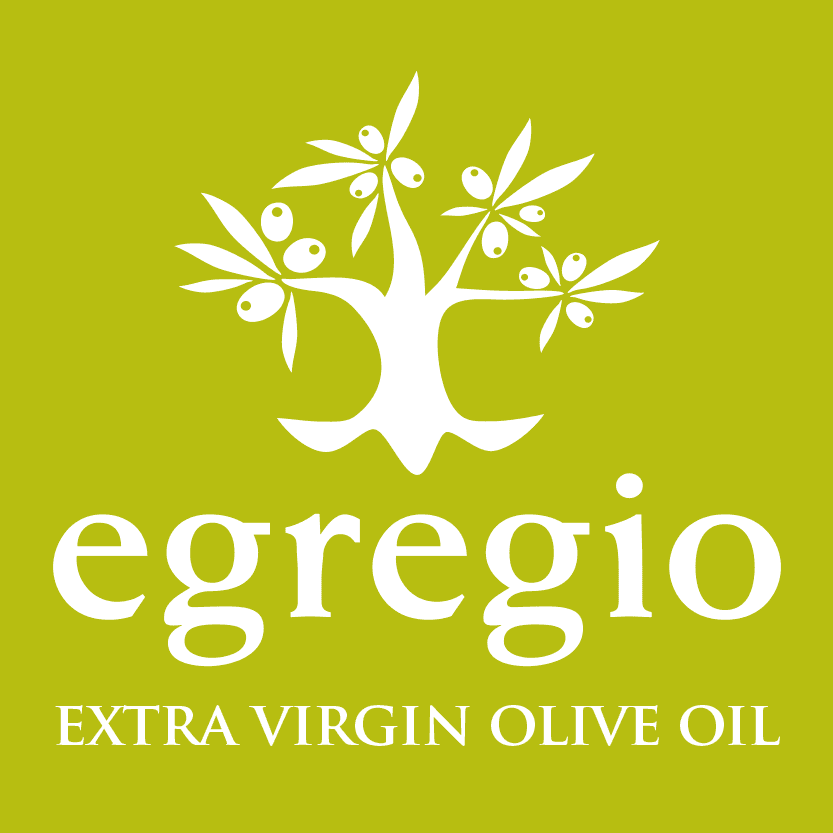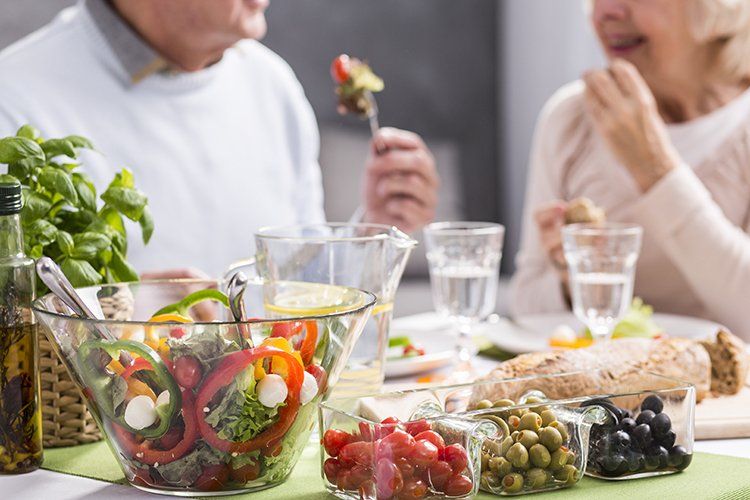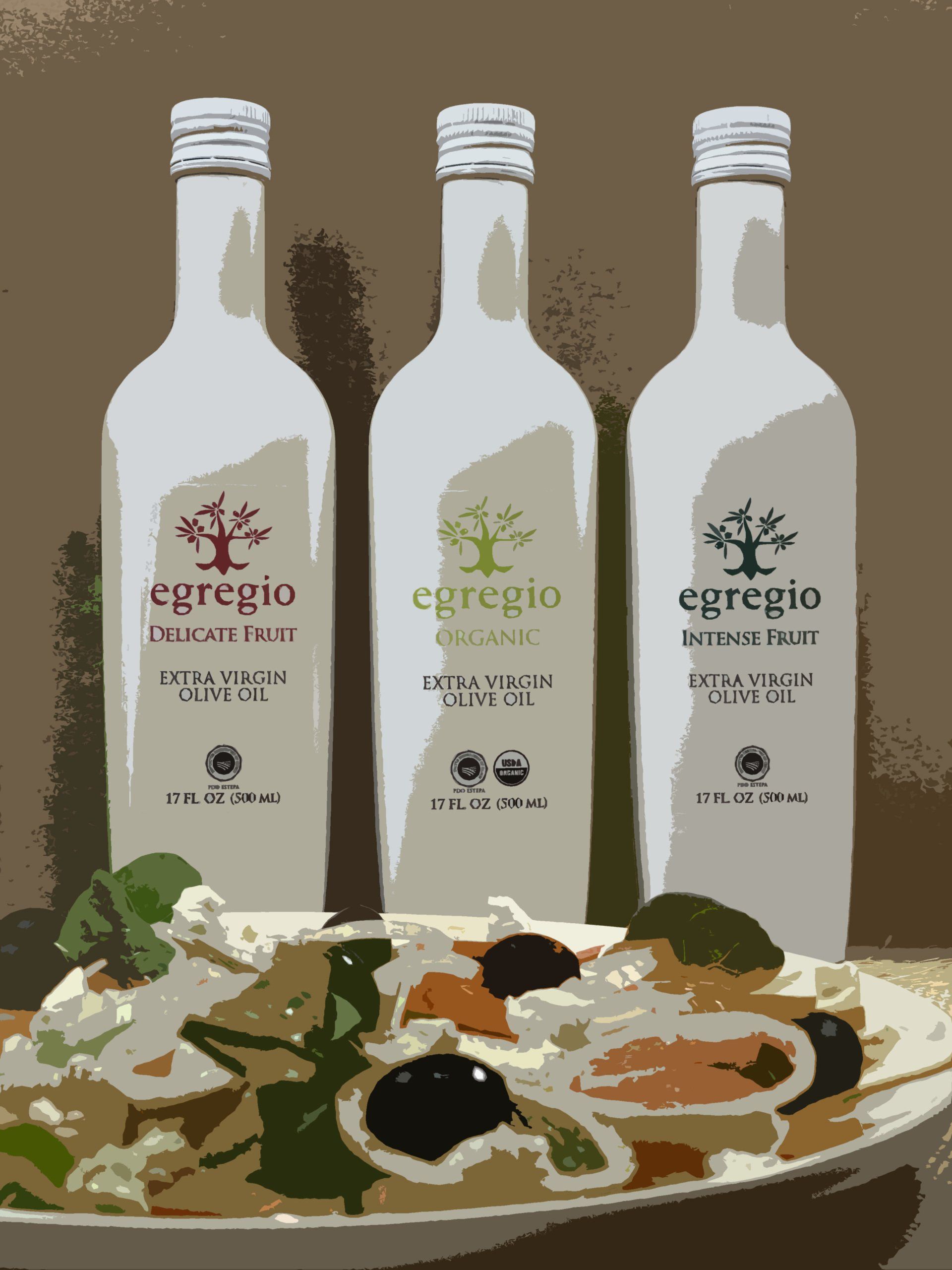
This recognition corroborates the one recently received as the best #EVOO of the 2020-21 Harvest in the Estepa Denomination of Origin contest, which was organized by its Regulatory Council. To this award is added the recognition of its high quality achieved in competitions in NEW YORK, CANADA and JAPAN. This excellent EVOO was cold extracted in our mills from Lora de Estepa in November, using only early-harvest organic Hojiblanca olives. The result is a very fruity EVOO, with aromas reminiscent of green olives and hits of ripe olives, freshly grass and artichoke. Spiciness and bitterness are mild and balanced, and there is a hint of sweetness. EGREGIO is available in gourmet stores and in the online store: https://www.egregioextravirgin.com/store
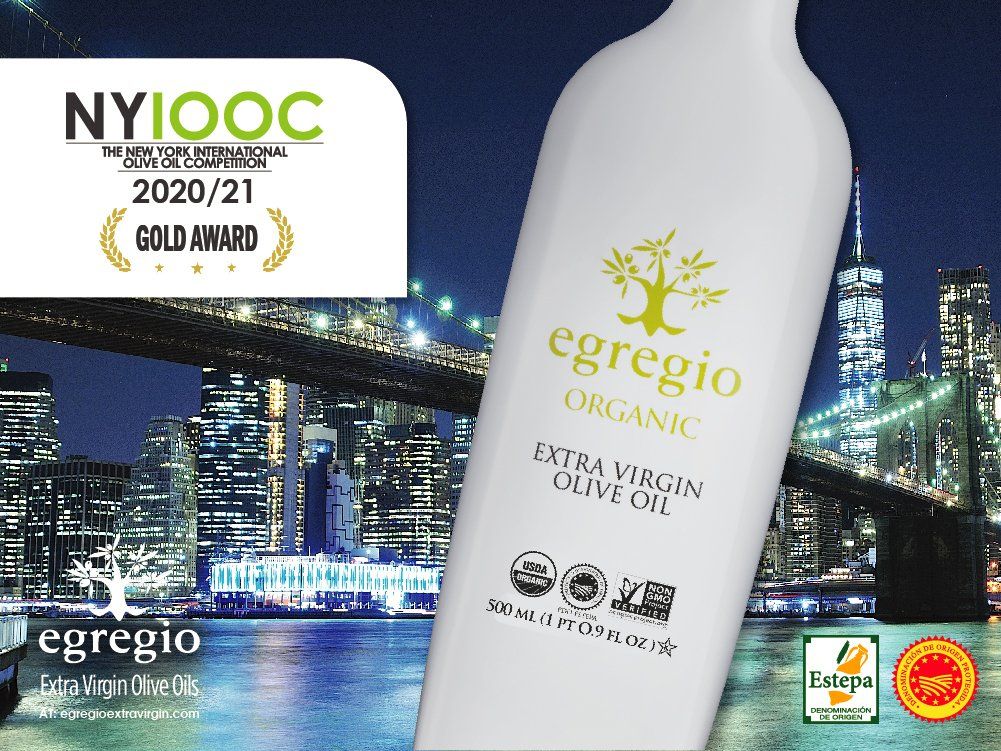
This recognition corroborates the one recently received as the best #EVOO of the 2020-21 Harvest in the Estepa Denomination of Origin contest, which was organized by its Regulatory Council. This excellent EVOO was cold extracted in our mills from Lora de Estepa in November, using only early-harvest organic Hojiblanca olives. The result is a very fruity EVOO, with aromas reminiscent of green olives and hits of ripe olives, freshly grass and artichoke. Spiciness and bitterness are mild and balanced, and there is a hint of sweetness. EGREGIO is available in gourmet stores and in the online store: https://www.egregioextravirgin.com/store
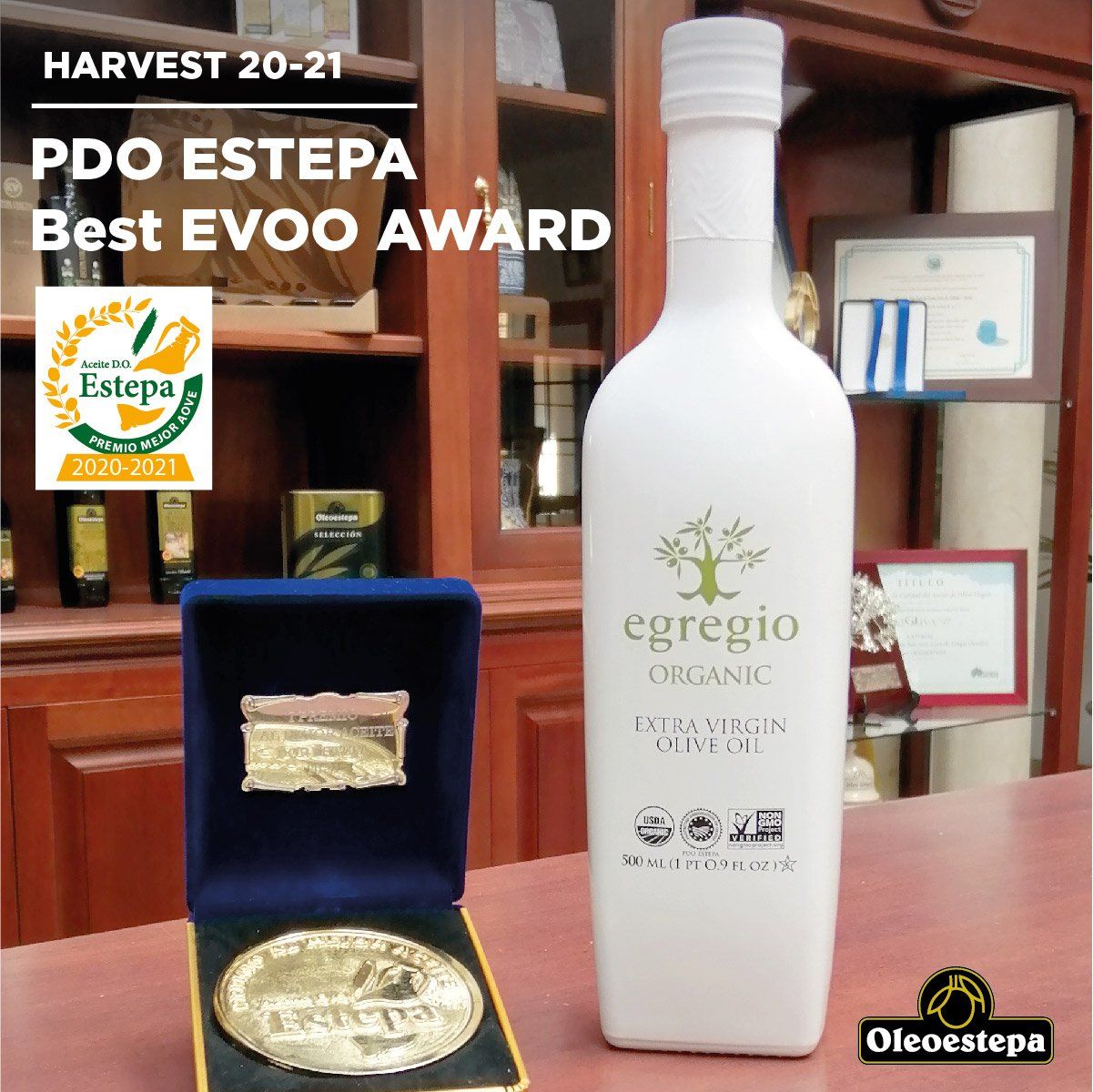
The Estepa Protected Designation of Origin has celebrated the first edition of the award for the quality of extra virgin olive oil produced in its territory. The award for the best EVOO of the Estepa PDO for the 2020/21 harvest campaign has gone to one of the associated oil mills of Oleoestepa SCA, named San José de Lora de Estepa oil mill. Oleoestepa bottle the awarded EVOO under the brand of organic extra virgin olive oil EGREGIO , a Premium reference available in gourmet stores and its online store by clicking here . EGREGIO EVOO comes from organic farming, early harvest and cold extraction. It presents a complex and balanced profile, very fruity, with a diversity of aromas reminiscent of green olives, with hints of ripe olives, fresh grass, green leaf, artichoke and green branch wood. In the mouth, the spiciness and bitterness stand out, harmonious and very balanced, complemented with a touch of sweetness. The contest organized by the Estepa Denomination of Origin is based on two unique milestones that are not presented in any other contest in the world. First of all, participants must have a deposit of at least 40,000 kg of extra virgin olive oil, which forces participants to have a high level of generalized demand in its production. Secondly, all the oils presented must comply with the specifications of the Estepa Designation of Origin, the most demanding in the world on certifying the high quality of an extra virgin olive oil. This award recognizes the great work of the associated oil mills located in the territory protected by the Estepa Designation of Origin in the development of a sustainable olive grove and an extra virgin olive oil of the highest quality.

It´s important that we know the definition of organic extra virgin olive oil, which is: “oil that comes from organic farming, a production system that uses agricultural methods that respect nature and the environment, with very strict rules on the use of herbicides, pesticides and synthetic chemical fertilizers” Egregio Organic Extra Virgin Olive Oil is produced in Estepa, a small town in the south of Spain where each olive is harvested in a sustainable way while protecting nature and the environment as much as possible. For us, the most important thing about extra virgin olive oil is not only the quality but also how the oil has been harvested and produced. Here you have just a few reasons to consume Egregio Organic Extra Virgin Olive Oil: - Avoid chemicals. ... - Benefit from more nutrients. ... - Enjoy better taste. ... - Avoid GMOs. ... - Preserve our ecosystems. ... - Reduce pollution and protect the quality of the water and soil. ... - Preserve agricultural diversity. From Egregio we encourage you to consume organic extra virgin olive oil and enjoy its benefits!
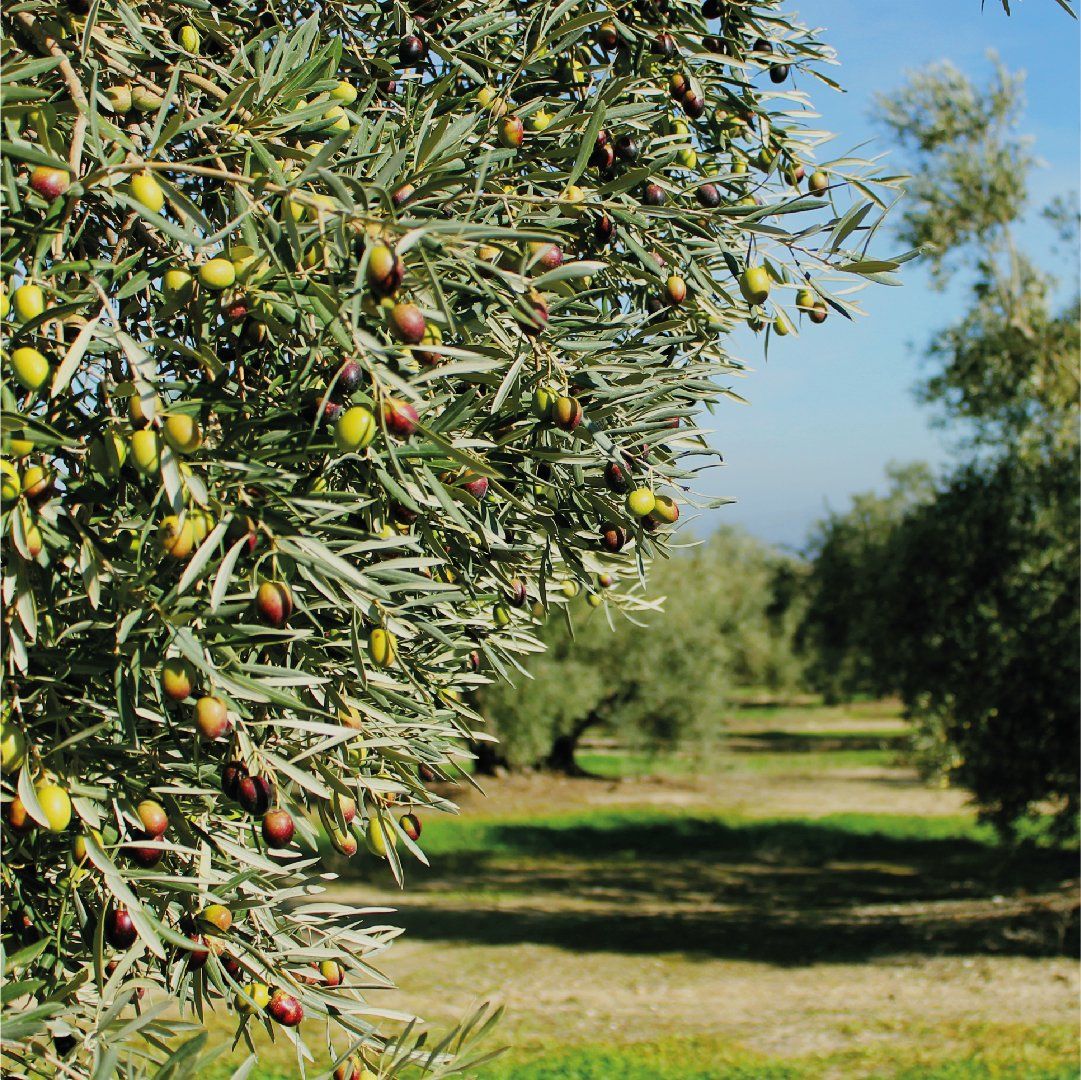
Did you know that great olive oil is the opposite of great wine? While some quality wine gets better over time, all great extra virgin olive oil gets worse. The fresher the better. Consuming fresh extra virgin olive oil will allow you to experience the most all of the amazing flavors and aromas, adding more flavor to each dish. Consuming fresh harvest oil also ensures low levels of oxidation, high content of polyphenols and oleic acid, which have a direct impacts on your health. Our November 2020 harvest Fresh Egregio Extra Virgin Olive Oil has just arrived! Egregio Intense for hearty plates such as meats or veggies, Egregio Delicate for fish or poultry, and Egregio Organic for your everyday needs. All Egregio Extra Virgin Olive Oil is farmed sustainably from our family of farmers.

Preparation: For the stuffing: 1. Cut the bread into small cubes, dice the onion and celery and chop the parsley. 2. Bake the bread in the oven for several minutes until golden. 3. Heat the Egregio delicate fruit olive oil in a pan and sauté the onion and celery until soft. 4. Mix the onion and celery with the remaining ingredients in a large bowl. For the turkey: 1. Preheat the oven to 325ºF (165ºC). 2. Mix the Egregio delicate fruit olive oil with the garlic, rosemary, basil, oregano, parsley, onion powder, thyme, red pepper flakes, black pepper and salt in a bowl. Set aside. 3. Wash the turkey inside and out. Leave it to dry. 4. Remove any large fat deposits and gently loosen the skin from the breast without tearing it, working your fingers into the area between the breast and skin. 5. Place the stuffing inside the turkey cavity. 6. Spread the Egregio delicate fruit olive oil and herb mixture over the outside of the turkey and between the breast and skin. 7. Place the turkey in a roasting pan with a rack and put it in the oven. Add about half a cup of water to the bottom of the pan and leave the turkey to roast for three to four hours. Ingredients For the turkey: • 1 whole turkey (about 4kg) • 250ml Egregio delicate fruit extra virgin olive oil • 3 tablespoons minced garlic • A pinch of chopped fresh rosemary • A pinch of chopped fresh basil • A pinch of dried oregano • A pinch of dried parsley • A pinch of onion powder • A pinch of dried thyme • A pinch of red pepper flakes • 1 teaspoon ground black pepper • Salt to taste For the stuffing: • 450g crusty bread • 2 onions • Two celery stalks • 50g fresh parsley • 1 teaspoon dried sage • 1 teaspoon dried thyme • Salt to taste • Pepper to taste • 2 eggs • 50ml chicken broth
Portions: 4 Time of preparation: 30 minutes Ingredients: 6 large eggs ½ cup ricotta cheese ⅓ cup freshly grated parmesan cheese ¼ teaspoon salt Freshly ground black pepper to taste ¼ cup chopped spring onion ¼ cup of EGREGIO Extra Virgin Olive Oil Intense Fruit 2 small zucchini, or one larger one, washed and sliced into thin rounds (about 3/4 pound) Preparation: In a large bowl beat the eggs until frothy. Add the Ricotta and Parmesan and beat to combine. Add the salt and freshly ground black pepper. Set aside. Heat the EVOO in a 10-inch oven-proof stick-free skillet on medium high. When the oil is hot and begins to shimmer, add the chopped spring onions, sauté for a minute. Then add the zucchini slices. Stir so that the zucchini slices are all coated with some of the oil. Cook, stirring only occasionally (if you stir too much the zucchini won't brown), until the zucchini slices are lightly browned, about 5-6 minutes. Remove from heat. Remove zucchini slices from the pan with tongs or a slotted spoon to a bowl. Let cool for 30 seconds or so, and then stir the zucchini slices to the egg mixture. Reheat the skillet. There should be a couple of tablespoons of oil left in the pan, if not, add some. When the oil is hot, pour the egg mixture into the pan. Do not stir it. Reduce the heat to medium. Let the egg mixture cook. Run a spatula along the edge of the frittata, separating the cooked edges from the pan. Let the egg mixture cook until the bottom is golden brown and the top is beginning to set, about 5-6 minutes. Set the top rack 5 inches from the heating element in the oven. Preheat the oven broiler. Once the top of the frittata has started to set in the pan on the stove top, remove the pan from the stove and place it in the oven. With the broiler on, the door of the oven needs to be open. You can let the pan's handle stick out from the oven through the open door. Cook under the broiler until the top starts to become lightly browned, about 2 minutes. Alternatively, instead of using the broiler, you can place a plate face-down on top of the skillet. Flip the skillet over to release the frittata on to the plate. Then slide the frittata from the plate back on to the skillet. Let cook for a couple of minutes more until the bottom side gets browned. Slide the frittata out of the skillet onto a serving plate. Let cool for a minute or two and serve. Serves 2 to 3. For more details about Egregio Intense Fruit -click here-

Measures against CORONAVIRUS (COVID 19)
Suppliers and clients
In relation to the outbreak of Coronavirus (COVID 19) and following the recommendations of the World Health Organization and national health authorities, Oleoestepa SCA immediately applies a contingency plan with certain actions to reduce exposure and mitigate the risk for the health of its clients, employees and suppliers.
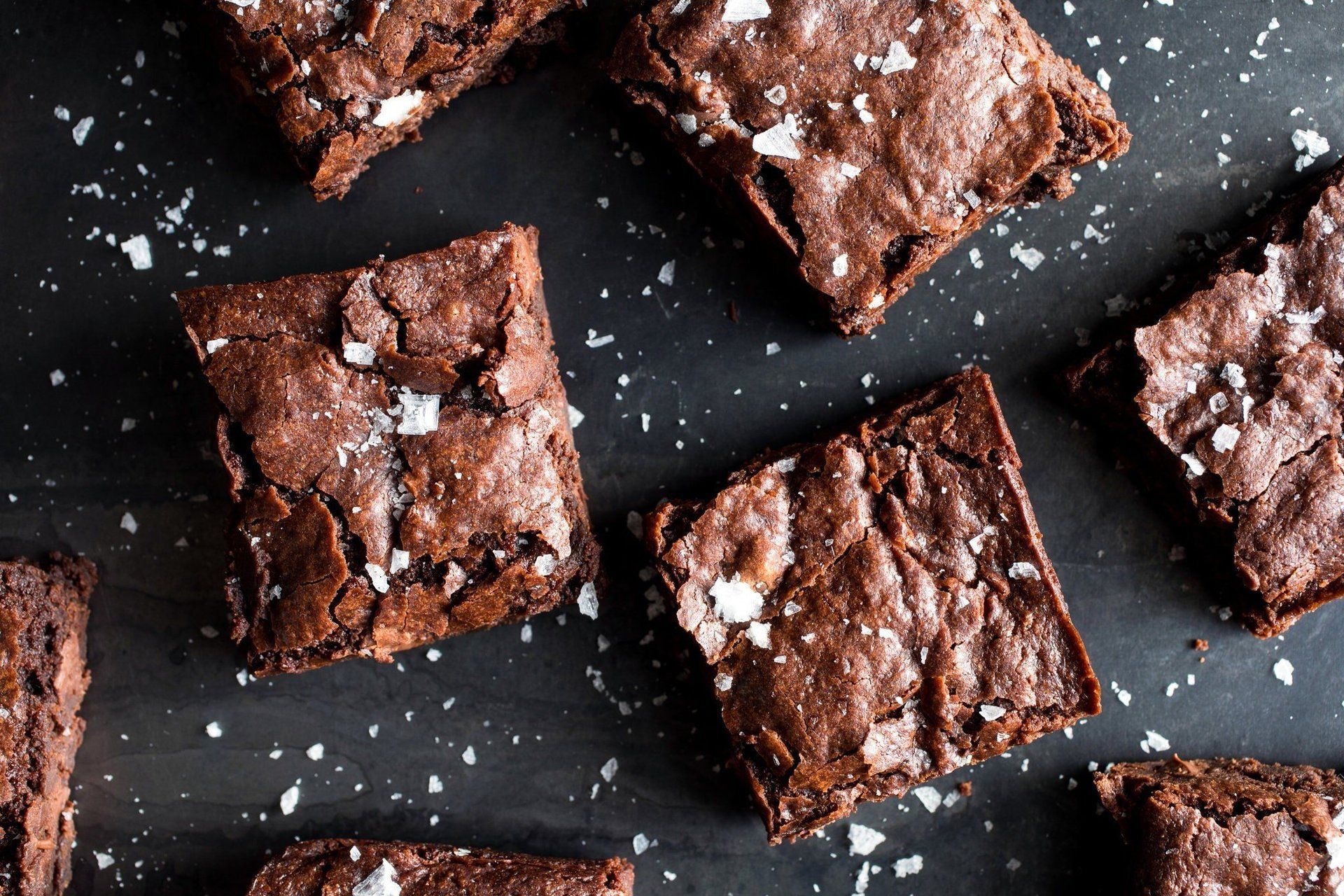
A latke fried in bubbling fat may be a classic way to celebrate Hanukkah, but it’s not the only nosh that can commemorate the oil-centric holiday. Olive oil brownies are another, albeit less traditional, option. This recipe is particularly suited to the task because, unlike others of its ilk, it skips the butter, relying instead on olive oil and the natural cocoa butter in chocolate to enrich the batter. The result is moist in the center, crisp at the edges and perfectly smooth but for the occasional crunch of a chocolate chip. Closer to ganache than to cake, these dense, dark treats are not for anyone who prefers a lighter, feathery type of brownie. They’re for people who live to lick the icing bowl. Because there’s no butter to soften its intensity, the flavor of the olive oil here matters a lot. Don’t use the grassy, sharp, highly aromatic stuff you’d drizzle on lettuce leaves. Choose something milder and more neutral. I use the same extra-virgin oil I cook with — a good-quality, midpriced workhorse. The olive oil gives these brownies a slightly savory quality, highlighted by a sprinkle of flaky sea salt that’s added right after baking. Make sure to sprinkle the salt while the brownies are still warm, which helps it stick. While showering them with salt before baking works with other, frothier brownie batters, it fails here, with the flakes sinking in and disappearing without a trace. Adding it at the end gives each bite a salty snap and a gentle crunch. For an even more pronounced crunch, add chopped, toasted nuts to the batter along with — or instead of — the chocolate chips. Or for an ultra-satiny batch of brownies that are just on the solid side of pudding, skip both nuts and chips, and let the salt provide the only textural contrast. Because these brownies are so deeply fudgy, a tester won’t come out clean even when they’re done. Instead, bake them until the batter looks and feels solid when gently pressed in the center. The brownies firm up enough to cut as they cool, but without losing their essential olive-oil gooeyness, which is a fitting tribute on Hanukkah — and utterly compelling during the rest of the year. Our recipe: https://www.egregioextravirgin.com/egregio-delicate-fruit1 For full article: https://www.nytimes.com/2018/11/26/dining/olive-oil-brownies.html?rref=collection%2Fbyline%2Fmelissa...

Jaime Loring smiles while holding a catavino stuffed with extra virgin olive oil. "My ancestors were exporters of wines and nuts - it supports the origin of their surname - and they came to Málaga 200 years ago." He runs an agricultural farm of 600 hectares, just olive groves, and the oil extracted from its fruit has been recognized as the best extra virgin in Spain for the fourth consecutive time by the Consumers Union (OCU). "It's no surprise anymore, but it's a joy for everyone." Oleoestepa is present in all communities (although especially in Andalusia and the Canary Islands) and in supermarkets such as Carrefour, Alcampo, Eroski, El Corte Inglés, Hipercor, Supersol and Aldi. As well as being a farmer, Jaime has been president of the Sor Ángela de la Cruz olive grove for 25 years, a cooperative associated with Oleoestepa , a second-order cooperative that brings together 17 mills and more than 5,500 families that cultivate 54,000 hectares of olive groves in the regions of Estepa and Sierra Sur in the province of Sevilla and Puente Genil in Córdoba . "Oil is a fundamental product for agriculture in the area; in Estepa, or put olive trees or put olive trees", he confirms. "It is a land in which any other crop would be very complicated to work; On the other hand, here the olive grove is wonderful." The conditions that Estepa meets are very favorable for the olive, mainly Hojiblanco and Arbequina, which annually gives 30,000,000 kilos of oils on average. "It is not an olive that falls to the ground, we collect it mostly from the tree and there is no excess moisture in the environment, which avoids having fungal problems -he continues-; It is a fresh land with little rainfall, which yields a more than acceptable yield. " The cooperative presided by Jaime has an average turnover of around 100 million per year and its production is mostly extra virgin. "The first years cost to bet for the quality, although the farmer was used to a clean collection - without mixing the collected in the ground with the one obtained from the own olive tree, but the farmers of Estepa have a high average of knowledge and are easy to convince to bet on quality ". In total, Oleoestepa produces almost 10 million bottles per year (more than 2.5 awarded by the OCU). From highest to lowest, they cost: 5.25 euros for bottles of one liter of extra virgin olive plastic, 25 euros for five liters of the same variety, 6.99 for extra selection 750ml and 10 euros for "Estepa virgin" of 500ml. 90% of the olive oil obtained from your mill is extra virgin. Its secret: an early collection of the olive in veraison, just the process in which the color of the fruit changes from green to purple, back in the months of November and December. At that point, the olive gives an exquisite juice, although in a much smaller production volume. ESTEPA, appellation of origin Rosa has been eleven years as agricultural technician of the API , Integrated Production Groups, and zigzags among the olive trees while observing in detail each plot, each fruit. "Do you see the terrain? -She asks to ask while looking down-; It has not stopped raining and maintains good conditions. " The young Estepeña studied to become Agricultural Technical Engineer at the University of Seville. "In the area where I grew up I thought that the best thing would be to do something related to oil," he says. Rain threatens and Rosa travels every hectare of the farm with her field notebook, where she writes down all the tasks that are developed in each plot. "The role of the API technician is based on quality, care for the environment and sustainability, monitoring traceability from the field to the grinding of olives," he says. we work in the control of the plagues of the olivar and advise to the agriculturalists that are our fundamental pillar ". "When the farmers come to bring us their olives we know all their way from the moment they bloomed in the fields until they became oil and they were stored in the cellar," he adds. That is, in his opinion, another of the secrets of Oleoestepa. The olive is known, and is pampered throughout his life in the olive tree. Pressed in less than 24 hours Rosa and Ricardo are brothers. She cares for the olive in the tree; he, when he is no longer there, is a master olive-grower and decides everything that is done in an oil mill. He has been training and learning for years from his predecessor, who retired a year ago. "Inherit the position of teacher has been a very bearable transition in time, have been many years learning from your hand," he tells EL ESPAÑOL. "He taught me a way of working that does not look at the clock," he says, "also to take care of all the points of the process, both the reception of the fruit, its classification, and all the parameters that influence the process." Although its day to day differs greatly from what the outgoing teacher lived, all the facilities are now controlled by an automaton, which facilitates the real-time master by a computer or a mobile phone. A little while ago and, after a week full of rain, the oil mill is barely active. The deafening noise of the machines is now calm, a breath before what is coming on Monday, with a more flattering forecast. Water always suits the countryside. Meanwhile, workers are striving to keep the facilities in perfect condition by the time the activity returns and production soars. "Only in this mill, we have reached almost one million kilos daily, Oleoestepa sets us a quality standard," says Ricardo ; We have to grind it before 24 hours from the olive harvest, but we try to do it in less time ". In 2015 they already lowered the 20-hour mark and in the last campaign it was possible to lower the age of 16. "In some cases we did not exceed two hours", presumes the teacher, agronomist training engineer. What is the secret of Oleoestepa? It is a calculation of several things, from the quality of the product to the treatment at the mill. I always insist a lot on the temperatures. For each line of work we have 10 or 12 temperature probes, where we set a maximum so that it is never exceeded; what today they call the elaboration in cold. If it is made with heat you get more oil than cold, but not with the same organoleptic characteristics. Our oils taste like freshly cut grass, green almond, aromatic herb; There are few oils with that kind of notes. It is difficult to remove this type of oil because many factors are involved, but if the fruit is good our duty is not to spoil it. It is very important to work in this way even if you get less quantity because it will be of higher quality. Great part of the secret of our success was the sensory analysis, introduced in the ninety-first year, and since ninety-five, the creation of our tasting panel. Thanks to him, we maintain a regularity in our oil profile during the three hundred and sixty-five days of the year, and when you open a bottle next year, it tastes like the bottle of the previous year. The quality of our product is therefore measured through some physical-chemical parameters but also by other sensory ones. The market buys for the smell or the taste and not for the chemical characteristics of the oil. The tasting panel, a well-kept secret Only one door remains closed in the Oleoestepa facilities. Few are those who manage to cross it when there is activity on the other side. Miguela keeps with zeal that nobody enters. She is responsible for laboratory and tasting panel, the only private space of these characteristics in the province of Seville. Nobody can distract the tasters during the process. "The tasting is fundamental, the main thing," confesses Miguela González,together with the managing director, the two most veteran employees of the organization. "Here we do not just fill in an attribute sheet, we also value the sensory notes that, depending on the variety or the time, will indicate the intensity of fruity or the flavors that you remember. The objective is to achieve a homogeneous profile throughout the year. " Twenty-three official tasters taste the different oils that Miguela offers them. From his verdict will come the pattern by which the quality of an extra virgin of Oleoestepa is guaranteed. These are external personnel with specific training and who only taste for this brand. "Everyone can be a taster," says Miguela. "But a good taster is made over the years." And ditch: "The chemical quality can be met by almost 100% of the oils, but it is the tasting that gives the category of extra virgin, and the Denomination of Origin Estepa is the most demanding in Europe, it is a guarantee of quality" . A cooperative of cooperatives An intermittent sun bathes the facade of the headquarters of Oleoestepa. There are still clouds picking up water in the sky. The cooperative was born 32 years ago, just with the entry of Spain into the European Economic Community, coinciding with an incentive movement of the associative movement. Currently, it is composed of 17 first-degree cooperatives, some 5,000 farmers and some 50,000 hectares of olive groves. The Oleoestepa is, with 90% of its production of extra virgin, the largest cellar of the best green gold in the world. At the head of it, at 52 years of age, 32 of them dedicated to Oleoestepa, is Álvaro Olabarría, managing director of Oleoestepa, little surprised at the recognition of the OCU . Its brand is above 40 other references of the main Spanish producers in both sensory and physical-chemical. And as a leader since 2003, the first time this study was published, which is produced every five years. Although when Oleoestepa started, nobody dared to think that so many recognitions would come. "From the first moment we were confident that we would know how to make extra virgin olive oil," says Olabarría . "Because the province of Seville was the first producer of table olives in the world and all our farmers were oriented towards this sector, which requires very special care", justified convinced. The extra virgin olive oil recognized by the OCU , which they call Big Consumption, is a mixture of different varieties, mainly Hojiblanca and Arbequina, to please the general public. It is sold in three different containers of one, three and five liters and its price ranges around five euros depending on the chosen size. You can buy on their website and in the main national distributors, but not all. This extra virgin is an oil with a very fresh, fruity aroma of green olives typical of Hojiblanca variety. Its aroma reminds of fresh grass, green olive leaf flavor with touches of apple and artichoke. Very fresh while delicate with elegant bitterness and itching. In addition to this product, which is successfully marketed in the United States for the catering sector, Oleoestepa also sells extra virgin monovarietals such as Hojiblanca and Arbequina. Or its internationally awarded Estepa Virgen, a selection of olives still in the veraison harvested at the beginning of November that harvested in 2013 the Gold Medal Mario Solinas granted by the International Olive Oil Committee, in addition to many other recognitions. "We are serious, responsible with our brands and passionate about extra virgin olive oil and we never deceive anyone," presumes Olabarría. Part of this success is also justified by the enormous competition between the 17 cooperatives that brings together Oleoestepa. Daily, and in real time, the members of the oil mills are getting to know the quality of the different oils and a classification is being established. "Here we do not pay for volume, here we pay for quality, we promote that pique among the oil mills and that shows in the final result", explains the managing director of Oleoestepa. Oleoestepa holds the vice presidency of QvExtra !, a private association whose purpose is to promote the competitiveness of producers of extra virgin olive oil. This international organization grants the SIQEV seal, a label that certifies that the product meets more stringent quality requirements than those required of any extra virgin. Currently it is made up of some 41 brands from all over the world. From the olive to the plate Not only the quality convinced Ceferino to use Oleoestepa oil in his restaurant. "This extra virgin is a number one, but being in Estepa if we use another one they can crucify us," he laughs. It is Wednesday and Ceferino has come, as every month, to buy the necessary oil to cover the demand of his establishment, the restaurant El Homenaje. This time, in addition, he takes a couple of bottles for his daughter, who goes to study in Paris . "The oil here is something that is given to friends as something very much ours, like the shortbreads and polvorones so typical of Estepa". In his day, decades ago, it was he and his father-in-law who sold Oleoestepa oil at the foot of the road, not far from where his current restaurant is today. "We used to sell cans and carafes and today I use it in the kitchen," he told reporters. In the dining room, apart from the olives, Ceferino pours a little extra virgin in a shell so that his clientele can taste it with a little bread. On the table he also puts some broken eggs with prawns and potato chips. All cooked with the, according to the OCU, the best extra virgin olive oil in Spain. "You put what you put, with this oil everything tastes better".
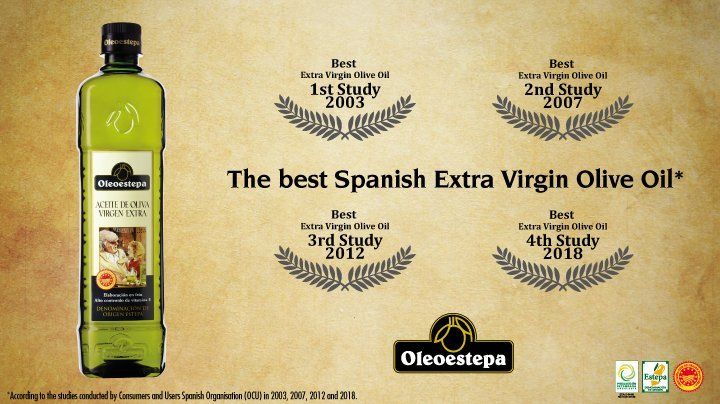
The latest study carried out by the Organization of Consumers and Users (OCU) which is set to officially publish on Monday October 29th, ranks the quality of the top selling extra virgin olive oils in Spain, once again placing the OLEOSTEPA brand, sister brand of EGREGIO Extra Virgin, both produced in Estepa, Spain, at the top with the highest quality in the national market. To carry out this study, the OCU has taken 41 references of the top selling extra virgin olive oils, submitting them to a physical-chemical and sensory analysis, also evaluating the information provided in their labels. The study presented by the OCU consists of the physical-chemical and sensory analysis (panel test) of 41 brands that hold the category of “extra virgin olive oil” found in supermarkets nationwide, where Spanish and International brands are present, with the OLEOESTEPA brand ranking the highest. This is a study that the OCU performs every 5 years, the previous editions having been performed in 2003, 2007 and 2012. In each year, OLEOESTEPA was awarded the first position in the quality ranking among the bestselling extra virgin olive oils in the national market. More info at: https://www.ocu.org/alimentacion/alimentos/test/comparar-aceite-oliva/results?filter=&sorter=

These days, the shelf of the cooking-oil section of the supermarket is a crowded spot. This abundance of oil options can cause confusion about which oils may be the healthiest ones to use. Over the past 10 years, the landscape of cooking oils has changed, said Jo Ann Carson, a professor of clinical nutrition at the University of Texas Southwestern Medical Center in Dallas. She pointed to the increased availability of high-oleic oils, the fairly recent arrival of coconut oil, and the wider availability of lesser-known oils such as grapeseed oil. With so many cooking oils out there, it can be difficult to make sense of the latest health headlines about dietary fat in general, Carson said. [ Special Report: The Science of Weight Loss ] Many consumers are confused about which types of dietary fat experts encourage or discourage in order to promote heart health, said Alice Lichtenstein, a professor of nutrition science and policy and director of the cardiovascular nutrition laboratory at the Tufts University Human Nutrition Research Center on Aging in Boston. Further complicating matters, there's been hype about coconut oil, and claims have circulated that "butter is back," Lichtenstein said. Lichtenstein was part of an advisory panel for the American Heart Association that wrote a report on dietary fats and cardiovascular disease. For the report, which was published in June in the journal Circulation, the panel did a careful review of the scientific literature to clarify some of the controversies surrounding dietary fat, she said. After evaluating the evidence, the panel recommended that Americans decrease levels of saturated fats (fats that come from meats, poultry, cheese, dairy products and tropical oils, such as coconut and palm oils) to reduce their risk of heart disease. People should replace saturated fats with unsaturated fats, which include polyunsaturated fats and monounsaturated fats, Lichtenstein said. The overall message is to encourage healthy fats in the diet by replacing animal fats with vegetable fats, Lichtenstein told Live Science. She said the bulk of the evidence favors polyunsaturated fats — found in fish, walnuts, and flaxseeds, as well as sunflower, safflower, soybean and corn oils — rather than monounsaturated fats, found in other types of nuts and seeds, avocados, and olive, canola and peanut oils. The data showed that if people replace saturated fats with polyunsaturated fats, they reduce their risk of heart disease somewhat more than if they replace saturated fats with monounsaturated fats. In other words, polyunsaturated fats may be a little healthier, especially for people concerned about heart health, Lichtenstein said. The panel's analysis of four so-called randomized, controlled trials — considered the "gold standard" of scientific evidence — showed that replacing saturated fat with polyunsaturated fat resulted in a 29 percent drop in the risk of heart disease. This reduction is comparable to that seen when people take statin drugs, according to the report. Replacing saturated fats with polyunsaturated or monounsaturated fats is good for the heart because it decreases the levels of LDL ("bad")cholesterol and as well as fats in the blood called triglycerides, both of which are risk factors for heart disease. Selecting oils So what do the findings of the report suggest about how you should use cooking oils? The main points are to use cooking oils in moderation, Lichtenstein said. The government's U.S. Dietary Guidelines recommend that Americans include a small amount of oils in their diets every day to supply essential fatty acids, because the body can't make these acids and thus must get them from food. There are two such fatty acids, and both are polyunsaturated fatty acids: linoleic acid and alpha-linolenic acid. But all cooking oils are composed of three different types of fatty acids: monounsaturated fats, polyunsaturated fats and saturated fats. Each oil is categorized based on which type of fatty acid is the most prominent in it. For example, olive and canola oils are considered mostly monounsaturated fat, while corn and soybean oils contain mainly polyunsaturated fat. Coconut oil is predominantly saturated fat. To help you select some of the healthiest oils while still pleasing your taste buds, here is a rundown of 10 cooking oils. Some oils have been well studied for their health benefits, while others have too little research from which to draw firm conclusions about their effects on heart health. (Story continues below infographic.)
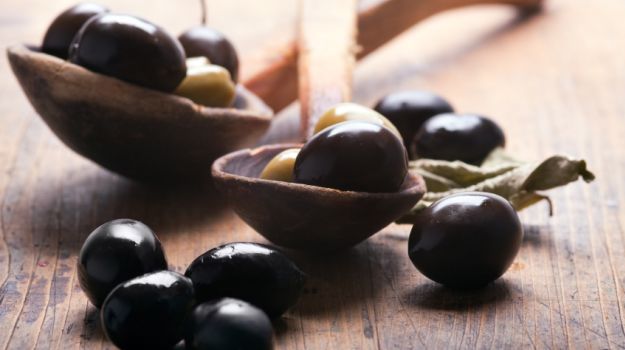
One fine day you finally walk into a supermarket to buy a bottle of olive oil because you are totally convinced with all the wonderful health benefits it provides. But, as soon as you reach the shelf, you are confused to see the diversity of choices. Of course, nobody told you that there are many types of olive oils that are available - from virgin to extra virgin and premium extra virgin. Which one should you buy? Or what is the difference between regular olive oil and the virgin variety? You'll find all your answers right here. The two most common types of olive oils, you may have heard of them before, are 'refined olive oil' and 'extra virgin olive oil.' Here's how both differ from each other in terms of extraction, nutritional value, use and flavour . How are both extracted? Both of them are obtained from the fruit of the olive tree but the way they are extracted differs. Regular olive oil is subjected to refining before being bottled. In this process, it may be treated with some additives and preservatives. It is light yellow in colour. On the other hand, extra virgin oil is the purest form of olive oil. It retains the golden-green hue of the olive fruit as it is not subjected to any industrial processes. It is the first juice of the fruit extracted through the process cold-pressing which is only filtered and then bottled as is. Therefore, extra virgin oil olive has a stronger flavour and aroma than regular olive oil which might be slightly bitter in taste. The gradation of olive oils is done on the basis of the level of acidity which refers to the content of Free Oleic Acid present in the oil. Regular olive oil has about 3-4% of oleic acid while extra virgin olive oil has less than 1%. The measure of free oleic acid in olive oil shows the degree to which fat has separated into fatty acids. Is there any difference in nutritional value? Extra virgin olive oil (EVOO) is the highest quality of olive oil because of the lesser amount of free oleic acid it contains which makes it a bit lighter. It also contains a slightly higher quantity of antioxidants like polyphenols. It is preferred because of its anti-inflammatory properties and natural olive flavour. All kinds of olive oils are highly rich in nutrients like vitamin E , vitamin K and minerals that make it heart-friendly as compared to other cooking oils. Olive oil (be it regular o extra virgin) is not as heavy as other refined cooking oils like mustard or sunflower oil and is lighter to digest. "More than the type of olive oil, the amount of oil used in cooking should be managed to lose and maintain weight . I recommend 2 to 3 teaspoons of oil which is the basic requirement of our body," shares Dietitian Reema Madhian from Noida. . Lastly, can they be substituted for each other? Regular olive oil and extra virgin olive oil are used for different cooking purposes. The primary difference in the use of regular olive oil and extra virgin olive is due to their smoke point. Smoke point is the temperature at which the oil starts producing bluish smoke. The smoke point of refined olive oil is slightly higher than that of extra virgin olive oil which means that it will take a little more time to burn. Therefore, it is better suited for high heat cooking techniques like frying . Extra virgin olive is great in salads as a dressing and can even be used for light sauteing. "The unrefined olive oil is obviously better than the refined one because of its purity and lower oleic acid content but that doesn't make it suitable for deep frying," adds Dr. Madhian. Armed with your newfound knowledge, we're sure you'll be able to make the best choice, the next you visit the supermarket. For the complete article: https://food.ndtv.com/food-drinks/what-is-the-difference-between-olive-oil-and-extra-virgin-olive-oi...

There's a lot of confusion around the best cooking oils that you should use for your health. The supermarket shelves are stuffed with a huge variety of different kind of oils and within those too there different types. You have virgin oils, extra-virgin oils, cold-pressed oils and even blended oils! The word extra-virgin refers to 'fine grade' oil. There are different varieties of olive oil that are set apart not by the type of olive that is used, but the process used to extract the oil. What is extra virgin olive oil? Extra virgin olive oil is obtained by crushing olives and extracting the fresh juice. It is unrefined and the highest-quality olive oil you can buy. Because of the way extra-virgin olive oil is made, it retains the true flavour of olives, and has a lower level of oleic acid than the other varieties. It has a higher concentration of natural vitamins and minerals found in olives. According to Consultant Nutritionist, Dr. Rupali Dutta, "Extra virgin olive oil is the first oil that comes out of cold pressing the olives. It has been subjected to zero processing, and has no additives which makes it bright green in colour and has a strong olive flavor. It also contains only 1% of Oleic Acid and is able to retain all its antioxidants . Regular olive oil, on the other hand, is commercially produced and processed just like any other oil. It contains at least 3-4% of Oleic Acid." inRead invented by Teads Ms. Ritika Sammadar, Consultant Nutritionist at Max Super Speciality Hospital in New Delhi, agrees, “Extra Virgin Oil is the clearest form of oil and is extremely healthy as it is rich in Vitamin B. There is no heat applied during its extraction nor are are any chemicals used in the process, thus the oil is pure and unrefined. The oil usually has a pungent smell because it is crude and pure.” How to use extra virgin olive oil Extra virgin olive oil has a subtle golden-green hue with a light peppery flavour. It has a lower smoke point than many other oils, which means it burns easily at a lower temperature. Therefore, it may not be suited for high heat cooking. Dr. Rupali Datta, advises, "It is better to use extra virgin olive oil only for raw or cold cooking. Indian cooking needs are not suited to substitute this oil for our regular vegetable oil. You can use it in salads , as dressings, for making breads and dips. Light sauteing can also be done using extra virgin olive oil." Here are six wonderful health benefits of adding extra virgin olive oil to your daily diet. 1. Full of good fats Extra virgin olive oil has high a percentage of omega fats (polyunsaturated fats that are good for your heart) along with monounsaturated fats. Delhi-based Dietitian, Dr. Deepali Solanki, shares, "Extra Virgin Olive Oil has a lot of monounsaturated fatty acids, unlike other oils which have a lot of saturated fat acids. It can be consumed in the same amount like any other oil . The recommended amount is half a liter per person per month." 2. Heart friendly According to the US FDA, having two tablespoons of extra virgin olive oil daily may reduce the risk of heart disease , due to its monounsaturated fat content. Some of the antioxidants present in extra virgin olive oil like oleocanthal and oleuropein are known for their anti-inflammatory action and help in reducing the levels of bad cholesterol which can be a risk factor for heart disease. 3. Rich in antioxidants The biggest health benefit of consuming extra virgin olive oil lies in its powerful antioxidant qualities. Extra virgin olive oil contains polyphenols which act as antioxidants, reducing the oxidative stress throughout your body. Antioxidants also help in promoting and strengthening your immune system making your body more resistant to infections and inflammation . 4. Helps in controlling diabetes People with diabetes are often advised to follow a diet rich in fiber from fruits and vegetables and monounsaturated fats instead of saturated fats and carbohydrates. A lot of studies show that having extra virgin olive oil as part of a balanced diet can help regulate blood sugar and improve insulin sensitivity. 5. Promotes brain health A small amount of Omega-3 and Omega-6 fatty acids present in extra virgin olive oil are essential for brain health. Scientifically, it has been seen that consumption of extra virgin olive oil may help in reducing the risk of Alzheimer's disease. A recent study published in the Annals of Clinical and Translational Neurology, shows that extra virgin olive olive may help protect the brain tissue against toxic substances that can cause Alzheimer's disease. 6. Aids weight loss Extra virgin olive oil helps in supporting your weight loss goals effectively. This is because of the satiating power of the fatty acids found in olive oil. This means that the regular consumption of extra virgin olive oil leads to a greater feeling of fullness. Extra virgin olive oil does contain calories but it is a healthier type of fat and is a great alternative to the others like butter or refined oils, especially if you are on a diet. In Greece, which consumes more olive oil than any other country, it is traditional to drink half a cup of extra virgin olive oil with lime water every morning to stay slim, prevent hunger pangs and increase longevity. You must consult a nutritionist to help you add extra virgin olive oil to your weight loss diet. Extra virgin olive oil is also naturally rich in Vitamin E and Vitamin A that makes it great for your skin . You can rub some oil on your face and see the difference. It penetrates deep into the skin, moisture it as well as adds a protective shield. For the complete article: https://food.ndtv.com/food-drinks/6-unexpected-extra-virgin-olive-oil-benefits-for-weight-loss-healt...

Researchers from the Lewis Katz School of Medicine at Temple University (LKSOM) in Philadelphia, PA were reported to discover that extra virgin olive oil could aid in preventing Alzheimer’s disease. Aside from that, olive oil was said to boost memory as well. According to News Medical, the U.S. Centers for Disease Control and Prevention deemed that Alzheimer’s disease is the most common form of dementia wherein there is no cure. However, the researchers found out that the most common component of the Mediterranean diet, extra virgin olive oil boosts the cognitive performance and could prevent Alzheimer’s in genetically modified mice. With that said, the study involved mice models that have the three components present in Alzheimer’s disease. The components were identified to be memory impairment, amyloid plaque buildup and neurofibrillary tangles. The mice were separated into two groups, wherein the first were fed a regular chow diet consisted of extra virgin olive oil while the second group has no extra virgin olive oil added to their chow diet. Moreover, the Alzheimer’s disease mice models were said to have no changes in physical appearance after several months after the experiment. Yet, the mice fed with extra virgin olive oil were mentioned to perform better when they reached the age of 9 months and 12 months old. “We want to know whether olive oil added at a later time point in the diet can stop or reverse the disease," as the study noted per Medical News Today. "Thanks to the autophagy activation, memory and synaptic integrity were preserved, and the pathological effects in animals otherwise destined to develop Alzheimer's disease were significantly reduced,” senior investigator and professor in the Departments of Pharmacology and Microbiology and the Center for Translational Medicine at LKSOM, Domenico Pratico said in a statement. Nonetheless, Pratico stated that extra olive oil was thought of better than vegetables and fruits long before and was mentioned to be healthier than saturated animal fats. Pratico then said that the reduction in the in autophagy marks the beginning of Alzheimer’s. The study was published in the journal Annals of Clinical and Translational Neurology. Related video: https://www.youtube.com/watch?v=dWcdBOYy_bU&feature=youtu.be For the complete article: http://www.sciencetimes.com/articles/17281/20170625/extra-virgin-olive-oil-discovered-preserve-memor...
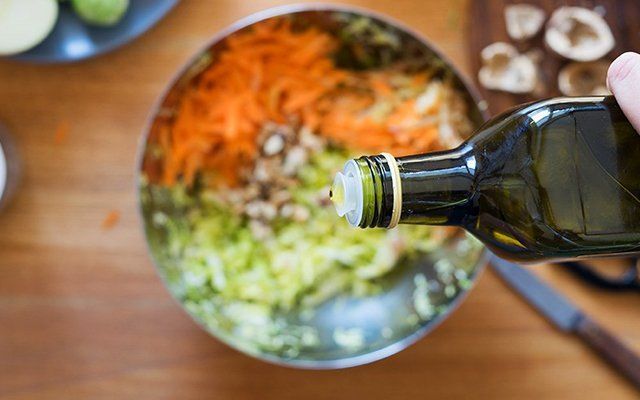
You now have one more excellent reason to shelve the store-bought dressing in favour of the homemade stuff: Eating a diet rich in extra-virgin olive oil may protect your brain as you age , researchers from Temple University suggest. In the study, researchers genetically modified mice to express three key characteristics of Alzheimer’s disease: memory impairment, the buildup of sticky proteins called amyloid plaques, and tangles of tau proteins. Then, when the mice reached six months of age, they had some mice eat chow supplemented with extra-virgin olive for six months, while the others ate their regular food. This food change occurred before the mice began to exhibit signs of Alzheimer’s. Related: How Sleep Apnea Hurts Your Memory At nine months and 12 months of age, the ones fed extra-virgin olive oil performed significantly better on brain tests that measured working memory, spatial memory, and learning. They also showed a reduction in the formation of amyloid plaques and less of a substance associated with tangles—as well as greater connectivity between neurons in their brains—than the mice who ate regular food. So how’s the healthy fat helping your brain? The researchers believe there are a couple mechanisms at play with extra-virgin olive oil. Not only does the oil reduce inflammation in the brain, but it also triggers a process called autophagy, when your cells break down and clear out debris and toxins, the researchers explain in a release . Related: Why Beer Is A Better Painkiller Than Panadol So if your cells are better able to clear out the bad stuff—which includes the amyloid plaques and tau protein tangles—they’re less likely to build up and contribute to nerve cell dysfunction that causes Alzheimer’s symptoms, they say. Still, because the research was done on mice, it’s hard to say whether the same findings would apply to people. But there’s no harm in trying to tweak your diet to more of a Mediterranean one—of which extra-virgin olive oil is a key component. For the complete article: https://my.website-editor.net/home/ed/site/48e1293a4130431d9899489c96e69bb7/blog
